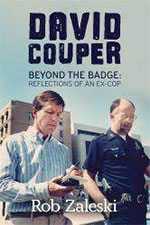 VERDICT: It’s a Keeper
VERDICT: It’s a Keeper
David Couper: Beyond the Badge – Reflections of an Ex-cop
By Rob Zaleski (Mineral Point, WI: Little Creek Press, 2022). 224 pgs. $18.95. Order, www.amazon.com.
Reviewed by Dianne Post
By the time David Couper had come to remake the Madison, Wis., police department, I had left Madison. During law school, I did an independent study, with Professor Herman Goldstein, writing new policies, procedures, and training for the police department along Couper’s new directions, although I don’t recall ever meeting him.
Author Rob Zaleski knows Couper well and covered him for years as a reporter, so personal and family history is included. This rounds out the character who over the years experienced contradictions and foreshadowing, which people don’t see until we are “seasoned.”
While I’m not enamored with the question-and-answer format of the book, it did cover the landscape from Couper’s youth in Minneapolis, his military career and sports interests, and his years in Madison as police chief to his post-policing activities as an Episcopal priest, a poet, a member of the Peace Council, and a teacher.
Many concerns and programs that Couper focused on remain policing issues today: from the percentage of people of color and women in the departments to militarization of the police to excessive use of force. Couper became a national leader during his time in Madison as a progressive chief and changed the department for the better but not without significant opposition and personal toll. During the struggles, people with the U.W. Law School, especially Herman Goldstein and Frank Remington, and the sociology department supported Couper the most.
At the time of the writing, Couper still lived in rural Wisconsin very near where I grew up. I was surprised to learn that he had been attacked by students at Platteville, which is 45 minutes from my hometown, because I thought that area of the state was more progressive and that the university would have been more supportive of First Amendment issues.
After discussing all the hot-button issues from abortion to obscene wealth, Couper says he is still progressive and recognizes that many of the same problems remain, for example racism, sexism, and unions running the police departments. As the Kerner Commission’s report made clear in 1968, we can go down one of two roads. We continue to choose the wrong one. WL
Dianne Post, U.W. 1979, spent 18 years doing family law and then transitioned into international human rights law.
 VERDICT: It’s a Keeper
VERDICT: It’s a Keeper
Like a Swallow: Looking Back at a Polish Childhood
By Nina L. Camic (Mineral Point, WI: Little Creek Press, 2022). 272 pages. $18.95. Order, www.amazon.com.
Reviewed by Melita M. Mullen
Like a Swallow darts from post-World War II Warsaw to cosmopolitan New York City and back again, stitching together Nina L. Camic’s detailed recollections of a girlhood spanning two cultures. A long-time professor at the University of Wisconsin Law School, Camic shares a remarkable family history, beginning with her maternal grandparents’ emigration from Poland to the United States. Camic’s grandfather worked for several years in the automobile industry and helped organize American workers who had emigrated from Poland, before he returned permanently to Poland in 1951, having been labeled a communist sympathizer.
Want to Review a Book?
Please request a book and writing guidelines from the Wisconsin Lawyer managing editor at wislawmag@wisbar.org. Reviewers may keep the book reviewed. Reviews of about 500 words are due within 45 days of receiving the book. Reviews are published, space permitting, in the order received and may be edited for length and clarity.
His daughter, Camic’s strong-willed Mamusia (mother), grew up almost entirely in the United States, becoming proudly fluent in English, only to return to Poland as the bride of up-and-coming Polish diplomat Bogdan Lewandowski. With his young family in tow, Camic’s father landed back in New York City, where he served as the Polish ambassador to the United Nations from 1960 to 1966. Thus, seven-year-old Nina had to navigate her family’s transition from their financially needy homeland to a nation of lavishly stocked shelves but scant tolerance for communists.
I was drawn to read Camic’s book as a sporadic reader of her blog (ninacamic.blogspot.com). Over time, I have come to know her from afar as a keen and generous observer of family life and the many places she has traveled. I enjoy her forthright and wry voice, her knack of being intimate and specific without oversharing. Her memoir displays the same qualities.
Camic shines when describing the texture and rhythms of daily life – relaxing with an after-school snack, singing with school friends, or nesting for the summer in her grandparents’ rural village. Very little escapes her clear gaze and curious mind, least of all the growing distance between her parents, who became restless captives of their careers and life choices.
When Camic returned to Warsaw for her high school years, she turned her attention to a tight-knit group of school friends, fell in love, and contemplated her flight path. Camic’s childhood came full circle when she seized a surprising opportunity to shape her future in the United States.
Throughout, Camic offers a bird’s-eye view of the intersecting political, religious, and cultural tensions that characterized Polish life in the late 1960s. In one memorable anecdote, such complexities reach full flower in Camic’s opportunity to see the Rolling Stones perform before an “orderly” crowd in Warsaw, a perk of her father’s position as a Communist Party bureaucrat.
Admittedly, this book will not appeal to lawyers who want to read about legal topics in their downtime. It will hold the greatest interest for those who prefer to follow threads away from the law into unusual places. Thanks to Camic’s deft storytelling and impressive memory, these adventure-seeking readers will emerge from Like a Swallow with a close look at a sliver of history unknown to many Americans.
Melita M. Mullen, U.W. 2012, is a shareholder at Bell, Moore & Richter S.C.
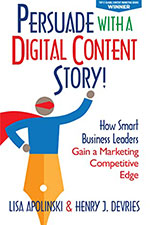 VERDICT: It’s a Keeper
VERDICT: It’s a Keeper
Persuade with a Digital Content Story! How Smart Business Leaders Gain a Marketing Competitive Edge
By Lisa Apolinski & Henry J. Devries (Oceanside, CA: Indie Books International Inc., 2021). 152 pgs. $7.71. Order, www.amazon.com.
Reviewed by Melinda Gustafson Gervasi
Storytelling is an ancient art that predates the written word. Stories help people understand and give meaning to shared human experiences. In addition, stories can be an effective way to cut through the digital noise to reach new clients, according to the authors of Persuade with a Digital Content Story! How Smart Business Leaders Gain a Marketing Competitive Edge. While the book is a slim volume, easily read in an afternoon, it provides a succinct overview of how to compose a compelling story and thereby improve a business’s digital content. The authors assert that high-quality digital content is best created through storytelling, allowing a business to connect with new clients, develop a brand, and foster return customers.
Organized into 15 chapters, the book begins with an examination of a six-step digital content story formula. The formula addresses how to deal with a main character, introduce a nemesis as well as a mentor, and use the story to share a moral. The book closes with a review of eight “metastories” that humans tell: the monster, the underdog, comedy, tragedy, quest, escape, rebirth, and mystery. The authors include examples and a discussion of each type of story, referring to modern stories and business-style books.
While the book does a great job of describing the anatomy of a story in general, it is a bit weak on exactly how storytelling is done differently in the digital world. Even though the authors open with the shocking statistic that Americans now spend an average of 40% of each day online, the book is lacking digital-specific techniques for storytelling.
Additionally, advertising by lawyers is subject to ethics rules. It would be wise to read this book with a copy of the Wisconsin Supreme Court Rules open in another tab on your browser or on the desk in front of you. I am certain no one wants to provide the fact pattern for a future ethics seminar hypothetical that is a cautionary tale on crossing the line into false or misleading advertising because of deceptive storytelling. (See, for example, SCR 20:7.1 Communications concerning a lawyer’s services.)
If, like me, you enjoy weaving a good narrative, I recommend you read Persuade with a Digital Content Story! How Smart Business Leaders Gain a Marketing Competitive Edge. It is a short and entertaining book with a solid summary of crafting a compelling story.
Melinda Gustafson Gervasi, U.W. 2001, operates a solo practice in Madison, where she has focused on estate planning and probate law for 17 years. She also holds a master’s degree in public administration from the University of Southern California.
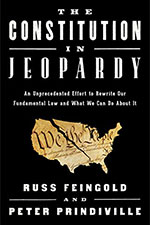 VERDICT: Touchdown!
VERDICT: Touchdown!
The Constitution in Jeopardy: An Unprecedented Effort to Rewrite Our Fundamental Law and What We Can Do About It
By Russ Feingold & Peter Prindiville (New York, NY: PublicAffairs, 2022). 320 pgs. $29. Order, www.amazon.com.
Reviewed by Thomas L. Shriner Jr.
The Constitution in Jeopardy, by former Wisconsin Senator Russ Feingold and one of his former law students, Peter Prindiville, is well researched, well written, and well worth the read. It deals with Article V of the U.S. Constitution, governing amendments. The book’s concern is not with the process used for the 27 existing amendments – proposals by two-thirds of each house of Congress and ratification by three-fourths of the states. Rather, it focuses on Article V’s alternative method – proposal of amendments by a new constitutional convention, which Congress would be required to call on application by two-thirds of the state legislatures.
Legislatures have applied for another convention many times since 1789, when New York sought one to adopt a bill of rights. Congress’s desire early in the 20th century to avoid having to call a convention when the number of applications neared the crucial two-thirds may have contributed to its proposing what became the 16th (income tax) and 17th (direct senatorial elections) Amendments. And efforts have been underway for the last dozen or so years to get 34 legislatures to force Congress to call a convention that would propose measures such as state legislative override of federal actions, repeal of the federal income tax, and restrictions on agency rulemaking power.
The authors are in a quandary because they think that this never-used convention process remains a desirable democratic mechanism to get around a politically divided Congress, which holds a monopoly over proposing amendments, and a conservative Supreme Court, which controls interpretation of the constitutional text and can thereby frustrate political efforts to accomplish certain policy changes at the national level. The quandary arises because the convention process is susceptible to being manipulated by what the authors call the “hard-right” advocates pushing their current campaign. Thus, “the Constitution in jeopardy.”
The principal concern seems to be that a new convention, though summoned for purposes articulated in the legislatures’ applications, could (as the 1787 one did) take up other matters or even start from scratch and propose a whole new constitution, severely limiting the government’s powers, choking off the revenues to fund it, or repealing protections such as those in the First and Fourth Amendments. This “runaway convention” possibility might arise because Article V contains no procedural rules. Its text requires Congress to call a convention “on the application of” the requisite number of legislatures and does not limit what a convention can propose.
What Congress can (and the authors think it should) do is to enact rules now – before a real situation presents itself – governing when “the application of” 34 legislatures will require it to call a convention. “Counting” rules could, at the least, state the effect Congress will give to limitations in the applications’ stated reasons for the call (in deciding whether the intents of the various legislatures show sufficient overlap to justify counting them together) and specify the requirements Congress can impose on the contemporaneity of the applications, to the same end. The book makes a compelling case that there is much to think about.
Tom Shriner, Indiana Univ. Bloomington 1972, is a partner in Foley & Lardner’s Milwaukee office, an adjunct professor at Marquette University Law School, a member of the Wisconsin Judicial Council, and a curator of the Wisconsin Historical Society.
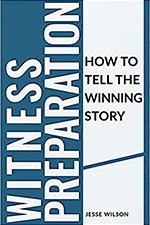 VERDICT: It’s a Keeper
VERDICT: It’s a Keeper
Witness Preparation: How to Tell the Winning Story
By Jesse Wilson (Portland, OR: Trial Guides LC, 2022). 221 pgs. Order, www.amazon.com.
Reviewed by Frederic W. Knaak
Any experienced lawyer trying jury cases knows the importance of effective storytelling, not only when framing the case for a jury but also to have witnesses convincingly add the needed narratives.
But learning the right technique by anything other than one’s own hard-earned experience (often at the expense of clients) or the experience of other lawyers can be difficult. To be sure, we may get the rare treat of an actor teaching the art of presentation at an occasional continuing legal education program, but for most lawyers, high-paid consultants to assist in witness and case preparation are the stuff of TV fiction or an occasional article.
Enter, stage left, Jesse Wilson, a very successful actor and director and now a witness and trial consultant who has been assisting lawyers in large-verdict cases for several years. In Witness Preparation: How to Tell a Winning Story, Wilson shares the theatre- and drama-based techniques that he uses in assisting lawyers with client and witness preparation for depositions and trials.
Much like preparing an actor for a part, Wilson invites lawyers to tell a story in a compelling way by focusing on clients and visualizing them as “victors” instead of being “victims.” For example, rather than instructing a teacher whose lack of mobility after an accident left her angry, frustrated, and deeply depressed to only talk about her pain, Wilson encouraged her to think of what she did that was positive. The teacher talked about a few students for whom she was a key adult. She talked about what she did for the students and why it was important. In a very real sense, she lived to teach such students. The teacher emerged from her cocoon. Only then was the issue discussed of how the injury made that more difficult, always in the context of how the injury limited her ability to help.
What the jury saw was the positive image of a good person, trying to do well, a “victor,” who had a positive focus and was not awash in misery. Interestingly, and somewhat counterintuitively, Wilson noted that coming across as a victor need not lessen the damages but in many instances would make it easier for jurors to award them.
Bringing a client or other witness to the point of being a victor in the story takes no small amount of work and can encounter obstacles. One situation involved a client who was one of several people abused in a prison setting. With considerable work with Wilson and her attorney, she was able to create a stable, positive framework for herself and her story. What hadn’t been anticipated were the client’s serious difficulties in confronting authority figures during a deposition. The deposition was, by Wilson’s candid admission, a disaster (although the case, in the end, did result in a positive and substantial verdict for the plaintiffs). More work was done on the client’s “victor” story, including on her thinking about the people she hoped would hear the story: ultimately her child and the jurors.
Wilson also has used his techniques to help experts make their testimony something jurors will want to listen to. He has a chapter on when lawyers need to “die” (that is, get their egos out of the way), adverse-witness preparation, experts, and the cost-effective use of focus groups.
The book is very much worth the time. It is readable and relatable. We are never too old, wise, or experienced to learn a few new tricks, and there are more than a few here to entertain and inform.
Frederic W. “Fritz” Knaak, Minnesota 1978, is with HKB Law P.A., St. Paul, Minn.
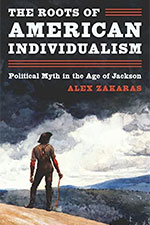 VERDICT: Not for Me, Maybe for You
VERDICT: Not for Me, Maybe for You
The Roots of American Individualism: Political Myth in the Age of Jackson
By Alex Zakaras (Princeton, NY: Princeton Univ. Press, 2022). 432 pgs. $39.95. Order, www.amazon.com.
Reviewed by Mark C. Young
Everyone should know by now that George Washington did not chop down cherry trees. That he did so is only one of many myths in American history. The myths in this book are of a different sort and present pictures of how Americans view themselves and the United States. According to author Alex Zakaras, a professor at the University of Vermont, myths offer lessons about who Americans are, now and throughout history.
According to current surveys, Europeans look to their governments to more actively address their needs, while Americans are more inclined to value freedom to “pursue life’s goals” without interference from the state and to accept the consequences. This focus leads to U.S. public policy having more of a “libertarian tilt” than does the public policy of other modern states. Zakaras argues that the Jacksonian era of the 1820s and 1830s was fertile ground for the development of this self-determination focus. The period is one often depicted as welcoming the “common man” to a seat at the table of American politics. Zakaras describes it as “the first mass, egalitarian movement to make itself felt in American politics.”
Zakaras’s book is aimed at an academic audience, so the reader should not expect it to be a popular history or social commentary. Indeed, he delves more deeply into the weeds of the topic than will likely appeal to a general audience and might lose readers when he divides subjects into two or three subcategories rather than presenting a linear narrative.
Zakaras divides the U.S. population of the era into three groups, each with its own features: the independent proprietor, the rights bearer, and the self-made man. The allegedly wide opportunities of early America provided the opportunity for solitary farmers or merchants to make their claim to a piece of what would later be called the “American dream.” That dream was, however, available only to white males and closed effectively to women and minorities. Yet at a time when only 20% of adult men in England owned land, two-thirds of adult white males in America were landowners.
This emphasis on white male achievement carried some sorry baggage. White supremacy was a key part of a system based on chattel slavery and the federal government’s confiscation of land from Native Americans. Many governmental and private actions were grounded in racial stereotypes and assumptions. Although much was claimed in the name of “rights,” these rights were restricted to white males to the exclusion of Blacks, Native Americans, and women.
Taking land from Native Americans was justified by arguing that by not producing on the land as white settlers had done, they were not entitled to retain their land. Zakaras states that this argument, combined with chattel slavery, led to “the racialization of property rights in America, and the racism deep within it.” In the eyes of abolitionists, keeping people in bondage denied them the rights claimed by white Americans, while slave owners raised the banner of freedom of contract. Three decades later this pressure cooker would explode in the Civil War.
This a valid exploration of an important transitional period in American history, albeit not an easy read.
Mark C. Young, Drake 1978, practices in Milwaukee and is a member of the State Bar of Wisconsin’s Real Property, Probate & Trust Law Section.
» Cite this article: 96 Wis. Law. 30-35 (April 2023).
